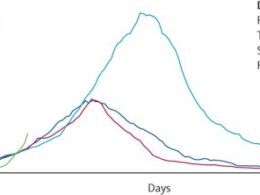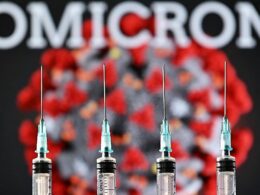According to an updated model from IHME
Fewer infections are likely to be detected: as a larger fraction of cases will be asymptomatic
IHME COVID-19 Model Insights Blog
December 22, 2021
IHME director and lead modeler Dr. Christopher J.L. Murray shares insights from their latest COVID-19 model run. Explore the forecasts: covid19.healthdata.org.
Key takeaways:
- Infections are predicted to increase: we will see about as many infections in the next 2–3 months as we have in the entire pandemic thus far.
- Fewer infections are likely to be detected: as a larger fraction of cases will be asymptomatic (about 90% as opposed to 40% of previous variants), fewer people will seek out testing and thus will not have their infections recorded.
- Overall hospitalizations and deaths will be lower than previous surges: the infection-hospitalization and infection-fatality rates of omicron are much lower than other variants like delta.
- How is omicron different? It is more transmissible, but much more likely to be asymptomatic and much less likely to result in hospitalization or death.
- Changes to the IHME model: we now track each variant individually and are taking into account waning immunity over time.
- Policy interventions that will help: increasing mask use and increasing the number of people getting a third vaccine dose six months after their second. Track hospital admissions rather than reported cases, as many cases will be mild.
- How to protect yourself as an individual:
- Get a third dose of the vaccine if you already have two, or get a first dose if you haven’t yet.
- Wear a high quality mask like a KN95 or N95.
- If you are at high risk due to age or comorbidities, avoid indoor gatherings.
- The severity of omicron is still uncertain: lags in data reporting around the new year mean we are unlikely to have clarity for another few weeks.
This transcript has been lightly edited for clarity
We have made a set of models for every country in the world that reflect the omicron variant — its dramatic spread around the world, the rapid surge in infections and cases — and we have modelled through to what that implies for hospitalizations and deaths until the beginning of April.
At the global level, we expect 3 billion or more omicron infections in the next two to three months, which will translate into a tripling of global reported cases. Because the infection-detection rate is going to be lower, that will translate into a global surge in hospitalizations, but fortunately smaller than the previous delta surge and previous winter surge in the Northern hemisphere. And even smaller will be the global impact in terms of mortality, but global deaths will go up somewhat in the next few months.
Infection Increase
While we expect — because of the increased transmissibility of omicron — the immune escape, we are going to see a huge increase in infections globally. Over the next three months, we expect about 3 billion or more infections. To put that in context, that’s as many infections as we’ve seen in the entire pandemic so far. So a really extraordinary increase in infections and daily infections at the global level will reach a peak over 35 million a day, sometime in mid-January. To put that in context to the enormous previous peak of the delta wave in India in April, that was a peak of about 12.5–13 million infections a day, so triple what we saw before.
It varies by country, based on how much infection recently with other variants and the vaccination levels, but at the global level and country by country, we’re going to see a truly enormous surge in infections.
Eventually, in our spread of omicron, we believe that omicron is going to reach all countries quite soon, given how quickly it has dispersed and how many asymptomatics there are. We expect even countries that have had very tight control of borders, such as New Zealand, because of the experience around delta, and even with managed border crossings (delta getting into the general population), and given that omicron is more able to do that, we should expect to see omicron surges in essentially all countries, including in China we suspect in the future.
Detected Infections vs. All Infections
We don’t expect reported cases, which is essentially infections that get diagnosed (get tested and confirmed as a case), whether they’re sympotomatic or a fraction of asymptomatics that get detected, but we don’t expect detected cases to surge as much as infections. Because there’s such a larger fraction of infections that are asymptomatic, many will not even seek out testing. Only those that are picked up by some routine screening program, either employee or school-based are likely to be detected, and therefore we expect to see the infection-detection rate (the fraction of infections that do get a positive test) will drop. We should see peaks that are smaller than the number of that massive upswing in global infections. Probably detected infections at the global level will be three times that previous peak that we saw for delta and in the US we expect to top out at somewhere just over 400,000 cases a day.
Hospitalizations & Deaths
The impact on hospitalizations and deaths is what everyone is most concerned about. That is what I think, if there is any shred of good news in what we’re seeing, that is where we can look.
Because of the greatly reduced infection-hospitalization rate, and the even more-reduced infection-fatality rate, this massive surge of infections and cases will translate into a smaller surge in hospitalizations than either the delta wave or the winter peak last winter at the global level.
That story will vary very much by country.
Australia and New Zealand should see a much worse epidemic than they have seen so far, but many countries should actually see a smaller surge, and certainly a smaller surge in deaths than their previous surges that they’ve lived through.
In a country like, for example, the United States, the numbers suggest that hospitalization will be possibly higher than the delta peak that we saw in early September, but about the same level as the winter peak last year, in terms of hospitalization. And then in terms of death, it should be either lower than the delta peak in September or the winter peak last year.
That story will be very different country by country. One country that is ahead of others in terms of managing this wave of omicron is the United Kingdom. In the UK, we expect to see a big surge in infections and cases, a surge in hospitalization, even though it’s not yet appeared, and then eventually a very modest increase in death, much lower than the previous winter surge last year in the UK.
How is Omicron Different?
Modeling the impact of omicron and understanding the impact of omicron, we need to go through the key aspects of the new variant that are going to determine the next two to three months.
1. So first, omicron we know is more transmissible. And perhaps even more importantly, there is what we call immune escape, that is that 40–60% of people that had been infected previously of another variant like delta or the ancestral variants, are still going to be susceptible to getting omicron. So the combination is what’s driving this very rapid increase in cases that we’re seeing in many countries.
2. Secondly, and very importantly for understanding the impact of omicron, is that the fraction of infections that are asymptomatic appears to be much higher. There are a number of sources of data, perhaps the most compelling from South Africa, but we’ve seen this in analyses from sports teams in the US as well, but it’s likely that we’ve gone from about 40% of infections being asymptomatic to over 90% and perhaps even as high as 95% asymptomatic.
3. Third, given the data that we have available from South Africa, the United Kingdom, Denmark, and Norway, we see that the infection-hospitalization rate, that is the fraction of infections that end up in hospital (different from the case-hospitalization rate, which is just hospitalizations divided by reported cases, but since many infections go undetected we’re talking about the infection-hospitalization rate), that is probably 90–96% lower for omicron than for delta.
4. Last, and certainly not least, is that the infection-fatality rate (the deaths out of those who get infected) is also dramatically lower in omicron compared to delta, likely 97–99% lower.
Changes to IHME Model
It’s been a number of weeks since we’ve had a model release and the reason is we’ve had to substantially modify our model to take into account two really fundamental things:
1. First, to be able to model omicron, we realized we really needed to be able to keep track of each variant on its own, infection with the ancestral variant or with alpha or beta or gamma or delta, and now omicron and a grab bag of other variants as well. If omicron is able to reinfect people that have had a previous infection with let’s say delta, as the science evolves we’ll learn more and more about the relationship between infection with one variant and the protection it gives for another variant. So we’ve revamped the model to capture and track different variants individually.
2. Secondly, we’ve taken into account waning immunity. What we’ve learned is that infection-acquired immunity and vaccine-derived immunity both wane over time. That waning is actually pretty fast for prevention of infection, maybe 50% reduction in immunity at 30 weeks or more depending on the vaccine. And that waning immunity for preventing hospitalization and death is fortunately slower than that. Even amongst the vaccines and vaccine-derived immunity, there’s quite a difference with Moderna having the slowest level of waning, followed by Pfizer, and much faster waning for Johnson & Johnson and AstraZeneca.
The other thing we’ve done in the model, is we are capturing the waning of infection-acquired immunity as well as vaccine-derived immunity. That will make a big difference to the forecasts we have for each location, depending on how recent the last delta wave was and where it may stand on vaccination.
Policy Interventions that Will Help
We’ve included new scenarios in our analysis.
We have a scenario where mask use goes up to 80% (we previously had a 95% mask use scenario, which is the level that some countries have achieved), but there hasn’t been a lot of progress in countries over the last year in mask use, so we have made a less ambitious, perhaps more achievable 80% target for mask use.
That has a really big effect, cuts transmission quite substantially, it cuts down on imported cases, it has a consequential effect on hospitalizations and deaths.
- So mask use comes out in our analysis as by far and away the most effective strategy to manage omicron right now.
- More rapid or increasing third doses of vaccinations, or increasing third doses above what we assume in the reference scenario, which is we assume that 80% of those that have been vaccinated with two doses in the past will get a third dose at six months. In this scenario, we increased that to 100%, so it’s a modest increment in who gets a third dose. That has some effect.
We have not modeled shortening the period of eligibility for a booster from six months to three or four months. That’ll be something coming in the future that’s likely to have a bigger effect than the one that we’ve modeled so far.
The other thing we’ve noted on the policy front is that many of the policies around testing in schools and workplace that evolved for prior variants, with much high infection-hospitalization rates and infection-fatality rates, and the required period of isolation after a positive test, are going to be very problematic during the omicron surge.
Because the numbers are so much larger for omicron, so many people will be asymptomatic. If you follow the same protocols, you may end up with some employers with a huge reduction in available staff. I think many organizations will have to rethink whether or not testing of asymptomatics and isolation is actually going to make a difference, and is worth the disruption in school or the workplace.
Last on the policy front, we’re clearly in an era where infections (most of them) are very mild, that even reported cases, many of them are going to be mild, it’s probably time, at least on the local level, to shift our focus from reported cases to what’s happening to hospitalizations.
We believe the timely, relevant metric to track in the future during omicron, is going to be hospital admissions. That’ll help keep focus on severe outcomes and what is happening in different communities.
We believe the timely, relevant metric to track in the future during omicron, is going to be hospital admissions.
How can individuals best protect themselves?
There’s a lot that individuals can do to protect themselves if they see the need.
- First, getting the third dose if you’ve already had two doses of vaccination substantially increases your protection against omicron.
- Secondly, for the unvaccinated and never infected, they’re the individuals at greatest risk.
So if you’re in that category, vaccination is really tremendously important for protecting you from hospitalization and death.
And if you are even previously infected, what we do know is that vaccination on top of previous infection is going to boost your immune response substantially and enhance your protection against hospitalization and death from omicron. - Third, wear a mask. As we’ve learned more and more throughout the pandemic, high-quality masks like KN95s and N95s are better, so the higher quality mask you can wear, the better you are going to be off in preventing transmission to you from others of omicron.
For those who are at increased risk due to age or comorbidities, it really makes sense if you want to minimize your risk to avoid indoor gatherings. That’s your safest strategy to reduce personal risk.
Remaining Uncertainties
In modeling omicron, the big challenge and the reason it’s taken us several weeks to get to the point where we have results for every country in the world, is the remaining uncertainties around critical aspects of omicron.
There is huge uncertainty about how severe it is. Although we put out in our reference scenario what we think is most consistent with the available data, we suspect that our forecasts may still be somewhat pessimistic on hospitalization and death.
The reason is that we’re just not seeing the increase in the United Kingdom in hospital admissions that we should be, according to our own model. That does open the door that in future revisions of the model, we may even reduce further the infection-hospitalization rate. We’ve already reduced it by a huge percentage, but we might need to reduce that further.
To encompass the other end of the spectrum, that things may be worse than what we’re seeing, that perhaps in places where there are more people that are unvaccinated and never infected, omicron could be much worse. We have got a more severe omicron scenario included in the release, and you’ll see in that, that infections and cases are the same, but hospitalizations and deaths are greater bcause we’ve erred on the higher side of the uncertainty intervals that are compatible with the available data on the infection-hospitalization rate and the infection-fatality rate.
There’s a third question, or issue around uncertainty, which is unfortunately we don’t expect data in the next two weeks to help resolve any of these uncertainties. Judging by last year, the period from December 20 until about January 2 or 3 is a period of increasing lags in reporting of cases, hospitalizations, and deaths, so much so that many efforts in governments a year ago at this time were very misled by the available data. So we probably won’t get further clarity on some of these assumptions around omicron until well into the second week of January.
In terms of what are we watching the most closely, that might be changed in future releases of our model, it’s really the fraction that are asymptomatic, the degree of immune escape, and of course severity, where the evidence may push us to it’s less severe than we previously said or possibly more severe than what we’ve said in terms of the infection-hospitalization rate and the infection-fatality rate.
Names cited
Simon Ray, Director of Research Strategy and Professor of Health Metrics Sciences at Institute for Health Metrics and Evaluation
Originally published at https://www.healthdata.org on April 5, 2021.












